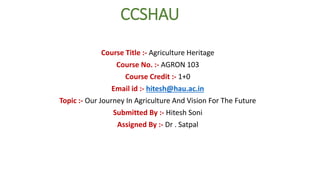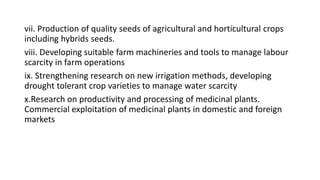- The document discusses the history and development of agriculture in India from famines in the late 19th century to present day. It summarizes key events like the establishment of the Imperial Agriculture Research Institute in 1905 and transfer to New Delhi in 1936.
- It outlines the current structure of agricultural research and extension in India, including ICAR institutes, agricultural universities, and KVK programs.
- It presents India's vision for agriculture in 2020 and research thrust areas, and highlights Koraput region being recognized as a Globally Important Agricultural Heritage System by FAO.


![• Our Journey In Agriculture And Vision For The Future
• The famine from 1876-78 led to institution of Famine Commission of 1880. The
horrors of Famine (1889-90) convinced Lord Curzon that urgent attention must be
paid agriculture.
• Lord Curzon passed the Land Alienation Act (1900) and Cooperative Societies Act
(1904). Lord Curzon, the Viceroy of India with the generous donations from Henry
Phipps of the USA had founded the Imperial
• Agriculture Research Institute in 1905 at Pusa, a village in the Darabhanga district
of Bihar.
• The main building at Pusa was named after its donor as the Phipps Laboratory.
[PUSA stands for the donor of the Institute, Phipps of the USA].
• There was a disastrous earthquake in 1936 and Pusa suffered heavily.
• After careful consideration the Government of India rebuilt the institute at New
Delhi. The transfer to New Delhi was completed by October, 1936.
• In 1947, India had about 27 Agricultural and Veterinary Colleges including the
Indian Agricultural Research Institutes, Indian Veterinary Research Institute and
five other Agricultural Colleges established during the first decade of the century.](https://image.slidesharecdn.com/56116113951550867309-220923115029-5a1f1c6c/85/Agron-103-pptx-3-320.jpg)
![• The Indian Central Cotton Committee (ICCC) (1921) was formed as per
recommendation of the Indian Central Cotton Commission (1917-18).
• The Government of India appointed a Royal Commission in 1926 to
examine the condition of agricultural and rural economy in India.
• The Imperial Council of Agricultural Research (ICAR) was established
in 1929 as a Society under the Societies Registration Act, 1860. The
Society was registered on July 16, 1929. [After Independence, the
name of the society was changed to Indian Council of Agricultural
Research (ICAR)].](https://image.slidesharecdn.com/56116113951550867309-220923115029-5a1f1c6c/85/Agron-103-pptx-4-320.jpg)











